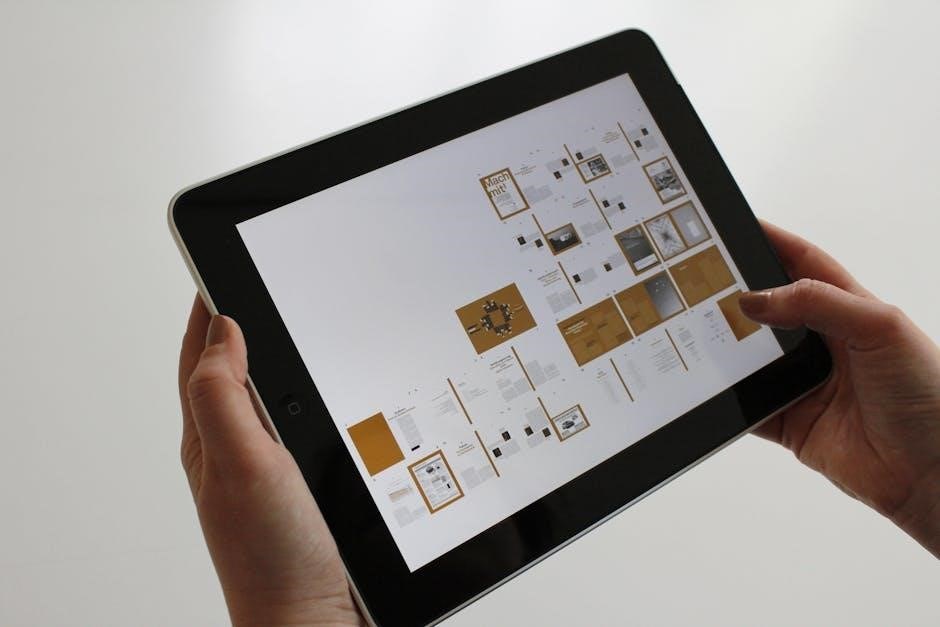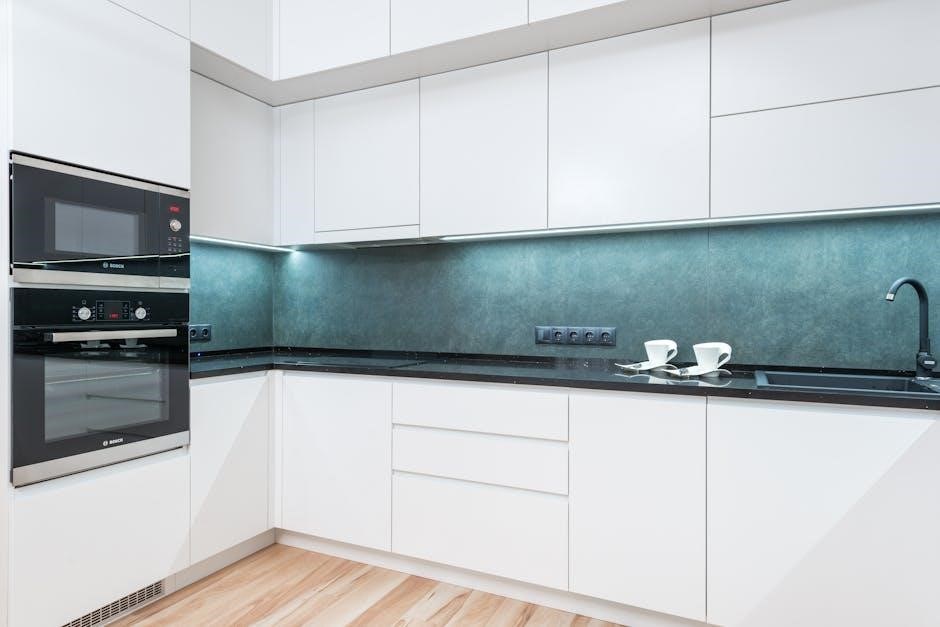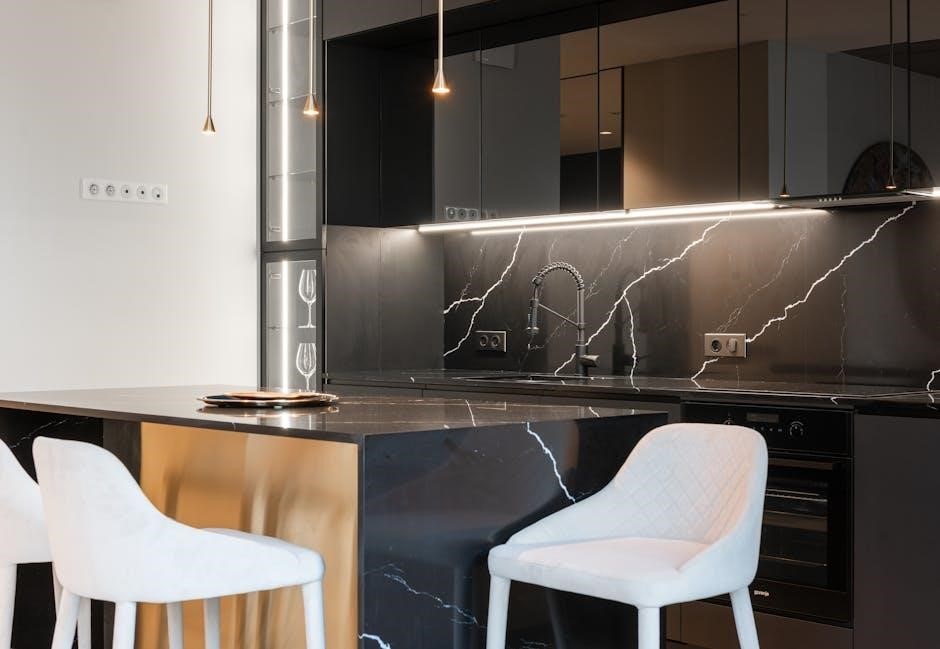Bosch ovens are renowned for their superior performance, sleek designs, and innovative features. This guide provides a comprehensive overview, helping you master your Bosch oven’s operation, from basic functions to advanced settings, ensuring a seamless cooking experience tailored to your culinary needs.
1.1 Overview of Bosch Oven Models
Bosch offers a diverse range of oven models, catering to different cooking needs and preferences. The Series 8 ovens are known for their advanced features and smart integration, while the 300 Series provides essential functionality at a more affordable price. The 800 Series stands out with its premium design and innovative cooking technologies. Each model is designed to deliver consistent performance, whether you’re a home chef or a culinary enthusiast, ensuring a perfect cooking experience tailored to your lifestyle.
1.2 Key Features of Bosch Ovens
Bosch ovens are equipped with advanced features designed to enhance your cooking experience. The AutoPilot function offers pre-programmed settings for effortless meal preparation, while the touch control interface provides intuitive navigation. Many models feature smart integration, allowing remote monitoring and control via smartphone apps. The self-clean function simplifies maintenance, and multiple rack positions ensure versatile cooking options. Energy efficiency and even heat distribution are hallmark features, making Bosch ovens a reliable choice for home cooks and professional chefs alike.

Installation and Setup
Ensure proper installation by positioning the oven level, securely connecting electrical and gas components, and following safety guidelines to prevent hazards and ensure stability.
2.1 Positioning and Leveling the Oven
Proper positioning and leveling are crucial for safe and efficient oven operation. Ensure the oven is placed on a stable, even surface to maintain balance and prevent vibration. Use a spirit level to verify the oven’s alignment, adjusting the feet or base as needed. If the floor is uneven, use shims to achieve a level surface. This step ensures even heat distribution and prevents potential safety hazards, aligning with Bosch’s installation guidelines for optimal performance and longevity.
2.2 Connecting Electrical and Gas Components
When connecting your Bosch oven, ensure the electrical and gas components are installed by a qualified professional. Turn off the power and gas supply before starting. Check that all cords and hoses are undamaged and compatible with the oven’s specifications. Follow Bosch’s installation guidelines to secure connections properly. Verify that the electrical plug matches the outlet rating and that gas lines are leak-free. Double-check all connections after setup to ensure safety and optimal performance, adhering to local regulations and manufacturer recommendations.

Basic Operation
Mastering basic operation ensures smooth cooking. Start by preheating the oven, then use the control panel to set temperature and timer. Select the desired cooking mode and monitor progress through the display. Adjust racks as needed for optimal results. Always refer to the user manual for specific instructions tailored to your Bosch oven model.
3.1 Setting Temperature and Cooking Time
Accurate temperature and timing are crucial for perfect cooking. Use the dial to set the desired temperature in 10°F/5°C increments. Enter cooking time via the timer function or dedicated buttons. Select the appropriate cooking mode (e.g., bake, roast) using the control panel. The display will show the set temperature and remaining time. For even cooking, ensure racks are correctly positioned. Preheating is essential for consistent results. Always refer to the user manual for specific instructions tailored to your Bosch oven model.
3.2 Understanding Rack Positions and Usage
Proper rack positioning ensures even cooking and optimal results. Bosch ovens typically have six rack positions, with position 1 being the lowest and position 6 the highest. Use position 6 for hamburgers and steaks, position 5 for toasting bread or broiling meats, position 4 for thicker cuts, and position 3 for poultry and baked goods. Avoid using the top guide for rack support. Always refer to your Bosch oven’s user manual for specific guidance on rack placement to achieve the best cooking outcomes.

Advanced Features
Bosch ovens offer advanced features like AutoPilot for pre-programmed settings, timer functions for precise cooking control, and smart integration for remote monitoring, enhancing your culinary experience.
4.1 Using AutoPilot for Pre-Programmed Settings
The AutoPilot feature simplifies cooking by offering pre-programmed settings for various dishes. Select the type of food, and the oven automatically adjusts temperature, cooking time, and humidity. This ensures perfect results for meats, fish, and baked goods. Simply choose your dish, input the weight, and let AutoPilot handle the rest, providing a hassle-free, precise cooking experience every time.
4.2 Timer Functions for Start, End, and Countdown
Set your Bosch oven’s timer with ease using the dedicated buttons. Choose a start time, end time, or countdown option for precise control. The countdown function alerts you when cooking is complete, preventing overcooking. For added convenience, use the delayed start feature to begin cooking at a later time. This ensures your dish is ready exactly when you need it, offering flexibility and consistency in your culinary routine.
4.3 Smart Integration and Remote Control
Bosch ovens offer seamless smart integration, allowing you to control your appliance via a smartphone app. Enable remote monitoring and adjust settings like temperature and timer with ease. Receive notifications when cooking is complete. This feature enhances convenience, letting you manage your oven from anywhere. Ensure your oven is connected to a stable internet connection and the Home Connect app for optimal functionality. This smart solution streamlines your cooking experience, offering greater flexibility and control.

Maintenance and Cleaning
Regular maintenance ensures optimal performance. Clean racks and interiors manually or use the self-clean function. Replace oven light bulbs safely when needed for visibility during cooking tasks.
5.1 Self-Clean Function: Risks and Best Practices
The self-clean function simplifies maintenance by burning food residue at high temperatures. However, it poses risks like toxic fumes and potential damage to oven components. Before using, remove large food particles and racks. Ensure the oven is cool and ventilate the area thoroughly. Avoid using abrasive cleaners post-cleaning; Regular use can extend oven lifespan but follow manufacturer guidelines to prevent overheating or damage. Always refer to your Bosch oven manual for specific self-cleaning instructions tailored to your model.
5.2 Manual Cleaning and Oven Rack Care
For manual cleaning, remove racks and shelves, washing them in warm soapy water. Use a gentle cleaner and soft brush to avoid scratching surfaces. Avoid abrasive chemicals or scourers, as they may damage the oven’s finish. Regular wiping of spills prevents grime buildup. After cleaning, dry racks thoroughly to prevent rust. For tough stains, soak racks overnight before scrubbing. Proper care ensures optimal performance and extends the oven’s lifespan, keeping it hygienic and efficient for years.
5.3 Replacing Oven Light Bulbs Safely
Before replacing the oven light bulb, ensure the oven is cool and the power is turned off at the circuit breaker. Remove the light cover by unscrewing it, then carefully detach the old bulb. Insert the new bulb, ensuring it’s compatible with your Bosch oven model. Replace the cover securely. For added safety, avoid touching glass bulbs with bare hands and use a soft cloth to handle them. Regularly cleaning racks in the dishwasher can also maintain oven hygiene and performance.

Troubleshooting Common Issues

Common issues include error codes, stiff controls, and heating element malfunctions. Refer to the troubleshooting section for solutions to restore your Bosch oven’s optimal performance.
6.1 Error Codes and Their Solutions
Bosch oven error codes like E001, E005, or E011 indicate specific issues. E001 often points to a faulty temperature sensor, while E005 may signal a heating element malfunction. E011 could indicate a gas supply problem. Resetting the oven by unplugging it for 30 minutes often resolves temporary glitches. For persistent errors, check connections and clean sensors. Always refer to your user manual for code meanings and solutions. If issues persist, contact Bosch customer support or a certified technician for assistance.
6.2 Resolving Stiff or Non-Responsive Controls
If your Bosch oven’s controls feel stiff or unresponsive, start by cleaning the control panel with a soft cloth and mild detergent. Ensure no food residue or moisture interferes with the sensors. If the issue persists, unplug the oven for 30 minutes to reset the system. Check for loose connections or debris behind the controls. For mechanical dials, gently lubricate moving parts. If the problem remains, refer to your user manual or contact Bosch support for professional assistance to avoid further damage.
6.3 Addressing Heating Element or Fan Malfunctions
If your Bosch oven’s heating element or fan malfunctions, first check for error codes on the display, which can indicate specific issues. Ensure the oven is cool before inspecting the heating elements for visible damage or disconnections. For fan issues, verify if it runs during preheating or cooking cycles. Clean the fan and surrounding areas to ensure proper airflow. If problems persist, contact Bosch customer support or a certified technician for professional repair to avoid safety hazards and maintain optimal performance.

Safety Precautions
Prevent fires by removing food residues and ensuring proper ventilation. Never leave cooking unattended, especially when using oil. Turn off the oven immediately if it malfunctions.
7.1 Preventing Fires During Cooking
Preventing fires while using your Bosch oven is essential for safety. Always clean food residues and grease regularly, as they can ignite during cooking. Keep flammable materials away from the oven. Ensure proper ventilation to avoid gas buildup. Never leave cooking unattended, especially when using oil or frying. If a fire occurs, turn off the oven, unplug it, and smother flames by closing the door. Never use water on grease fires. Regular maintenance and inspections can prevent potential hazards.
7.2 Handling Oven Malfunctions Safely
When handling Bosch oven malfunctions, prioritize safety. Turn off the power and unplug the oven immediately. Avoid forcing stuck parts, as this can cause further damage. If the self-clean feature malfunctions, keep the oven door closed to contain heat and fumes. Never use water to extinguish grease fires. Ensure proper ventilation to prevent gas buildup. For complex issues, contact a qualified technician. Regular inspections can help identify and resolve potential problems before they escalate, ensuring safe and reliable operation of your Bosch oven.
7.3 Essential Safety Tips for Oven Usage
Always keep flammable materials away from the oven. Use oven mitts or tongs to handle hot dishes. Avoid overcrowding racks, as this can lead to accidents. Never leave cooking unattended, especially when using oil or fat. Ensure children are supervised near the oven. Regularly clean food residue to prevent fires. If a malfunction occurs, turn off power and vent the area. Never use water on grease fires; smother them instead. Follow Bosch’s guidelines for safe and efficient oven operation.

User Manuals and Support
Access Bosch oven manuals online for detailed instructions, troubleshooting, and maintenance tips. Visit the official Bosch website, enter your appliance’s model number, and download the PDF guide for easy reference.
8.1 Finding and Downloading Bosch Oven Manuals
To find and download Bosch oven manuals, visit the official Bosch website. Locate your oven’s model number (E-Nr) on the type plate. Enter this number in the search tool on the Bosch manual search page. Download the PDF manual, which includes installation, usage, maintenance, and troubleshooting guides. This resource ensures you have all the information needed to operate and care for your Bosch oven effectively.
8.2 Contacting Bosch Customer Support
For assistance with your Bosch oven, contact customer support via phone at (800) 944-2904 or through the online chat feature on the Bosch website. You can also submit inquiries using the contact form. Representatives are available to address questions, provide troubleshooting guidance, and offer repair service information. Bosch customer support is accessible 24/7, ensuring help is available whenever you need it.
8.3 Online Resources for Troubleshooting
Bosch offers extensive online resources to help troubleshoot common oven issues. Visit the official Bosch website for downloadable manuals, error code explanations, and repair guides. Utilize the interactive tool to determine if a professional repair is needed. Additionally, error code lookups and video tutorials are available to address specific problems. Online forums and community support pages provide user-driven solutions and advice, ensuring comprehensive assistance for resolving oven-related issues effectively.
